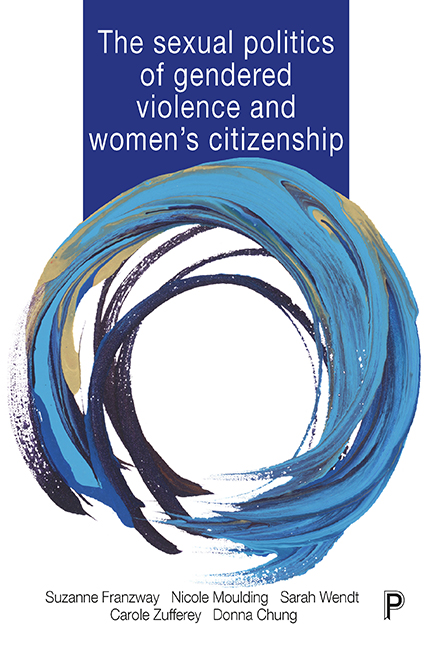Book contents
- Frontmatter
- Contents
- List of tables and figures
- Notes on authors
- Acknowledgements
- one The sexual politics of gendered violence and women’s citizenship
- two Problems of citizenship, violence and gender
- three Challenges of researching gendered violence
- four Living the connected effects of violence
- five Gendered violence and the self
- six Re-engaging lives
- seven Campaigns for women’s freedom from violence
- eight Transforming sexual politics
- References
- Index
five - Gendered violence and the self
Published online by Cambridge University Press: 13 April 2022
- Frontmatter
- Contents
- List of tables and figures
- Notes on authors
- Acknowledgements
- one The sexual politics of gendered violence and women’s citizenship
- two Problems of citizenship, violence and gender
- three Challenges of researching gendered violence
- four Living the connected effects of violence
- five Gendered violence and the self
- six Re-engaging lives
- seven Campaigns for women’s freedom from violence
- eight Transforming sexual politics
- References
- Index
Summary
Introduction
As one of us sagely observed when we were planning this chapter, it would be more remarkable if a woman did not experience mental health problems as a result of intimate partner violence (IPV) rather than if she did. It is hardly earth-shattering to point out that intimate partner violence has a serious deleterious effect on women's mental health and wellbeing. What is more noteworthy is the finding from our research that this negative impact often endures for many years afterwards. Unlike our own study, most research into IPV and mental health does not include women who left violent male partners many years ago, so there is usually a focus on the more immediate impact. Most existing research in this area is also concerned with establishing the links between IPV and mental illnesses such as anxiety, depression and post-traumatic stress disorder (PTSD). In so doing, a psycho-medical discourse of mental illness is implicitly adopted, most clearly demonstrated in the use of the language and definitions of the Diagnostic and statistical manual of mental disorders (APA, 2013), the diagnostic tool of psychiatry, medicine and psychology. Hence, while it is generally understood within this research that abuse is the primary cause of women's mental health problems in domestic violence, their psychological states are nonetheless tacitly defined as symptomatic of abnormal functioning or psychopathology. A host of potential consequences flows from this uncritical adoption of a psychiatric illness framework for the types of health and support services available to women who have experienced IPV.
Research linking IPV with the development of certain mental health conditions can be important – for example, it is useful in making the case for increased support services – but its dominance means that there is little attention paid to the phenomenology of women's distress and the impact of IPV on sense of self and identity. While psycho-medical constructions of women's mental health in IPV may not be as deeply pathologising as those applied to women who were abused in childhood, this narrow understanding does mean that, in practice, state-sponsored support for the mental health care of women who have experienced IPV is extremely limited, narrow in its orientation and focused only on one-to-one intervention.
- Type
- Chapter
- Information
- Publisher: Bristol University PressPrint publication year: 2018

